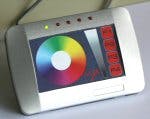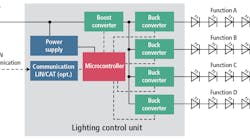The core of the device is a custom 16-bit MCU, implementing DMX512A and OpenDMX. The latter is based on DMX512A, but offers more possibilities such as file transfer, synchronous operation, and diagnostics, and it is a public-domain, license-free document (see below for more details).
The MCU uses a proprietary algorithm to translate finger position on the color wheel into a DMX signal, with a response time of 40 Hz. Four channels – red, green, blue and amber – are used.
There is also a "white" area in the center of the color scale. Gordan Rancic, director of technology R&D for LUX Italia, says that this are is not a "simple" white. "If you touch exactly in the center of the circle, you will reach 100% of all four channels," he says. "But if you move your finger for example, to the red color (but still inside white area), your white will gain in the red channel and lose some green channel. In this way you can 'trim' your white color as you like!"
To the right of the color circle, a dimmer surface allows the user to change the intensity of the chosen color from 1 to 100%.
"You can connect up to eight P1 units within the same DMX network," says Rancic. "One of them will become a 'master' while the others will operate as slaves. From the user point of view, nothing changes: you can switch the light on using one unit, change it with other unit and turn it off with any other of the eight P1s."
The P1 is powered with 80-240 VAC, consuming around 0.6W when active, and 0.1W when the light is off (only this is only the case when OpenDMX protocol is used, since there is a "Stand By" command that does not exist on DMX512A). Rancic says that the system was designed with the end user in mind. "The Whole system had to be user-friendly," he says. "You can't give 8 push-buttons to the user telling him "this is the red channel, this is green' and so on, and then expect him to correctly mix red, blue and amber to get violet."
From September 2007 two different forms of the P1 will be available, one of which is a luxury model costing about GBP 300 with mahogany "wings" and a special body resin similar to Mont Blanc pens. The standard model (P1L) will be just in plastic, planned for mass market, with a price of about GBP 150. Rancic says that the P1 potentially be used wherever DMX lamps are installed. "We are now working closely with some architects that found P1 very interesting for boutiques, jewelry stores and luxurious apartments," says Rancic. "The P1L was designed with hotels and yachts in mind. For the future, we have to wait that people start to use full color lamps at home..." LUX Italia is the brand of Phoenix Service, an Italian company that is involved in electronic design. "About one year ago we decided to focus our forces on LED lightning, and at the beginning of April 2007 LUX Italia was born," says Rancic. "Our aim is to produce 'Luxury Lighting Appliances', and some of our very innovative devices are now almost at the end of development."
OpenDMX protocol spec V1.0
OpenDMX is a shared document between several Italian lighting manufacturers. The first release was defined two years ago by Phoenix Service, and is a public-domain, royalty-free specification. It has been defined using the basic DMX frame, but running on a different, open-architecture set of commands.
Download the OpenDMX protocol spec V1.0 (PDF file, 150 KB)
If you have any comments or feedback on OpenDMX, please contact Gordan Rancic, director of technology R&D for LUX Italia.







